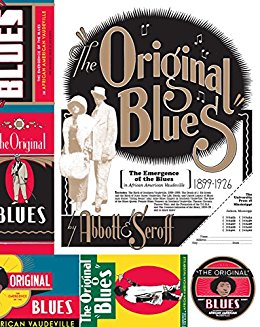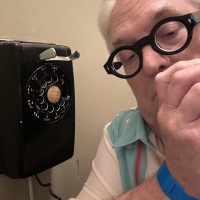Home » Jazz Articles » Book Review » The Original Blues: The Emergence of the Blues in Africa...
The Original Blues: The Emergence of the Blues in African American Vaudeville by Lynn Abbott and Doug Seroff
 The Original Blues: The Emergence of the Blues in African American Vaudeville
The Original Blues: The Emergence of the Blues in African American Vaudeville Lynn Abbott and Doug Seroff
420 Pages
ISBN: # 978-1496810021
University Press of Mississippi
2017
In the late 1970s, I began a more academic approach to blues music. In addition to listening to the music, I began reading everything I could find. One of the first books I read was Robert Palmer's sweeping narrative, Deep Blues: A Musical and Cultural History of the Mississippi Delta (Viking, 1981). It was here and in Samuel Charter's seminal The Country Blues (Reinhart, 1959) and Greil Marcus' Mystery Train: Images of America in Rock 'N' Roll Music (Dutton, 1975) that I was infected with the romantic notion of the America's Ur music, the blues.
My fascination was first with Robert Johnson, a phantom presence in the Mississippi Delta region who left 29 recorded sides and a skeletal biography. A mythology about Johnson and his antecedents and contemporaries grew out to the American Folk Music Revival that flourished from the mid-1940s to the 1960s. Something akin to James Fennimore Cooper's "Noble Savage" emerged, a pristine vision of African American folk music in its most basic, earthy, and unadulterated form. The image of the transient share-cropper/genius musician, rising mirage-like in a overheated dream from the hot blacktop of Highway 61, traveling hear and far, playing picnic, frolics, and roadhouses is what we were given. As compelling and comely as this sepia-colored version of the blues is, it was never accurate.
The past 10 years has seen a much needed correction in the cultural reportage of the blues. Beginning with Elijah Wald's essential Escaping the Delta: Robert Johnson and the Invention of the Blues (Amistad Press ,2005) placed Johnson in his proper context and identified who really founded the blues: largely white, obsessive, 78-rpm record collectors who went on to curate their music libraries and ultimately re-release the music on their personal record labels (thereby creating their own commodity), crowning their products: Anthology of American Folk Music (Folkways, 1952), The Country Blues (Folkways, 1959), Really! The Country Blues (Origin Jazz Library, 1965) as the "authentic blues." Rather than a blues originator, Robert Johnson was a precocious and talented youth who learned his craft like so many of us since, by listening to recordings. He is anything but seminal. That title remains applied only to Charlie Patton, Eddie "Son" House, Nehemiah "Skip" James, Willie Brown, and Tommy Johnson, all of who recorded a full decade before Johnson.
Following Wald's landmark book, other authors contributed to the discussion with notable books: Marybeth Hamilton's insightful In Search of the Blues (Basic Books, 2010); Ted Gioia's Delta Blues (Norton 2010); Daniel Beaumont's Daniel Beaumont: Preachin' the Blues -The Life and Times of Son House (Oxford University Press, 2011); Larry Birnbaum's Larry Birnbaum: Before Elvis -The Prehistory of Rock 'n' Roll (Scarecrow Press, 2013); Steve Cushing's Pioneers of the Blues Revival (University of Illinois Press, 2014); and Amanda Petrusich's Do Not Sell at Any Price: The Wild, Obsessive Hunt for the World's Rarest 78 rpm Records (Scribner, 2014) all have done their part in parsing properly the story of the blues. However, all of these examples represent as much critical as historical music reportage.
So, if the blues did not simply spring from the fecund dirt of the Mississippi alluvial plain, where might we find a dependable explanation for the music? Music scholars Lynn Abbott and Doug Seroff have spent the better part of the last 40 years researching the origins of African-American folk and popular music in their books Ragged but Right: Black Traveling Shows, "Coon Songs," and the Dark Pathway to Blues and Jazz (University Press of Mississippi, 2007) and Out of Sight: The Rise of African American Popular Music, 1889-1895 (University Press of Mississippi, 2009). They now complete their trilogy with The Original Blues: The Emergence of the Blues in African American Vaudeville capping a rigorously researched and academic body of work that goes a long way to telling the true story of the blues.
It should not be such a leap for us to wonder, "How did itinerant sharecroppers in the Mississippi delta learn the typical 12-bar blues, played largely with the I, IV, and V chords of a given key? Abbott and Seroff's book deftly provides ample evidence in the African-American minstrel and vaudeville traditions of the late 19th and early 20th centuries. Traveling shows would have been a ready place of exposure to the blues considering the large role singers like Ma Rainey and Bessie Smith played in their history. What we think of as the blues was being performed as early as 1900 and recorded as early as 1920 (Mamie Smith's "Crazy Blues" (Okeh 4169-A, 1920) considered the first blues of the standard style recorded). This is important as "Crazy Blues" was recorded several years before the seminal sides of Patton, House, (Tommy) Johnson, and James. These guys had to have heard it somewhere.
Abbott and Seroff, as they did in the first two volume of this trilogy, exhaustively researched American Black music, including the surrounding culture, business, and recording. The authors spared no time and expense in collecting source information, much of which was difficult to find. From this mass of information, they were able to construct a meaningful narrative tracing Black Vaudeville from its minstrelsy beginnings to its Gotterdammerung at the dawn of the recording age. The narrative is information and fact dense, making some of the reading slow going, but the research rigor and obvious love for the material make Abbott and Seroff's efforts a success and an important statement in the development of the subatomic particle of American Music, the blues.
Tags
Book Reviews
Bessie Smith
C. Michael Bailey
University Press of Mississippi
robert johnson
Ma Rainey
PREVIOUS / NEXT
Support All About Jazz
 All About Jazz has been a pillar of jazz since 1995, championing it as an art form and, more importantly, supporting the musicians who make it. Our enduring commitment has made "AAJ" one of the most culturally important websites of its kind, read by hundreds of thousands of fans, musicians and industry figures every month.
All About Jazz has been a pillar of jazz since 1995, championing it as an art form and, more importantly, supporting the musicians who make it. Our enduring commitment has made "AAJ" one of the most culturally important websites of its kind, read by hundreds of thousands of fans, musicians and industry figures every month.





















